Coaching and Mentoring: Supporting Individual Learning and Growth
VerifiedAdded on 2020/04/21
|8
|2025
|391
Report
AI Summary
This report delves into the concepts of coaching and mentoring as essential procedures for individual development across various settings, including workplaces and academic institutions. It differentiates coaching and mentoring from other learning and development methods, highlighting their time efficiency and focus on both new and existing skills. The report outlines the potential benefits for both coaches and coachees, as well as mentors and mentees, covering different types of coaching such as performance, skills, and career coaching. It further explores directive and non-directive coaching styles, the stages in a one-to-one coaching process, and the roles of coaches and coachees. The report also examines the nature and process of mentoring, including the roles of mentors and mentees, and introduces models like GROW and FUEL. Techniques such as effective questioning and feedback are discussed, alongside the importance of recording coaching and mentoring activities, with an example using the GROW model. The report emphasizes the role of coaching and mentoring in fostering lifelong learning.
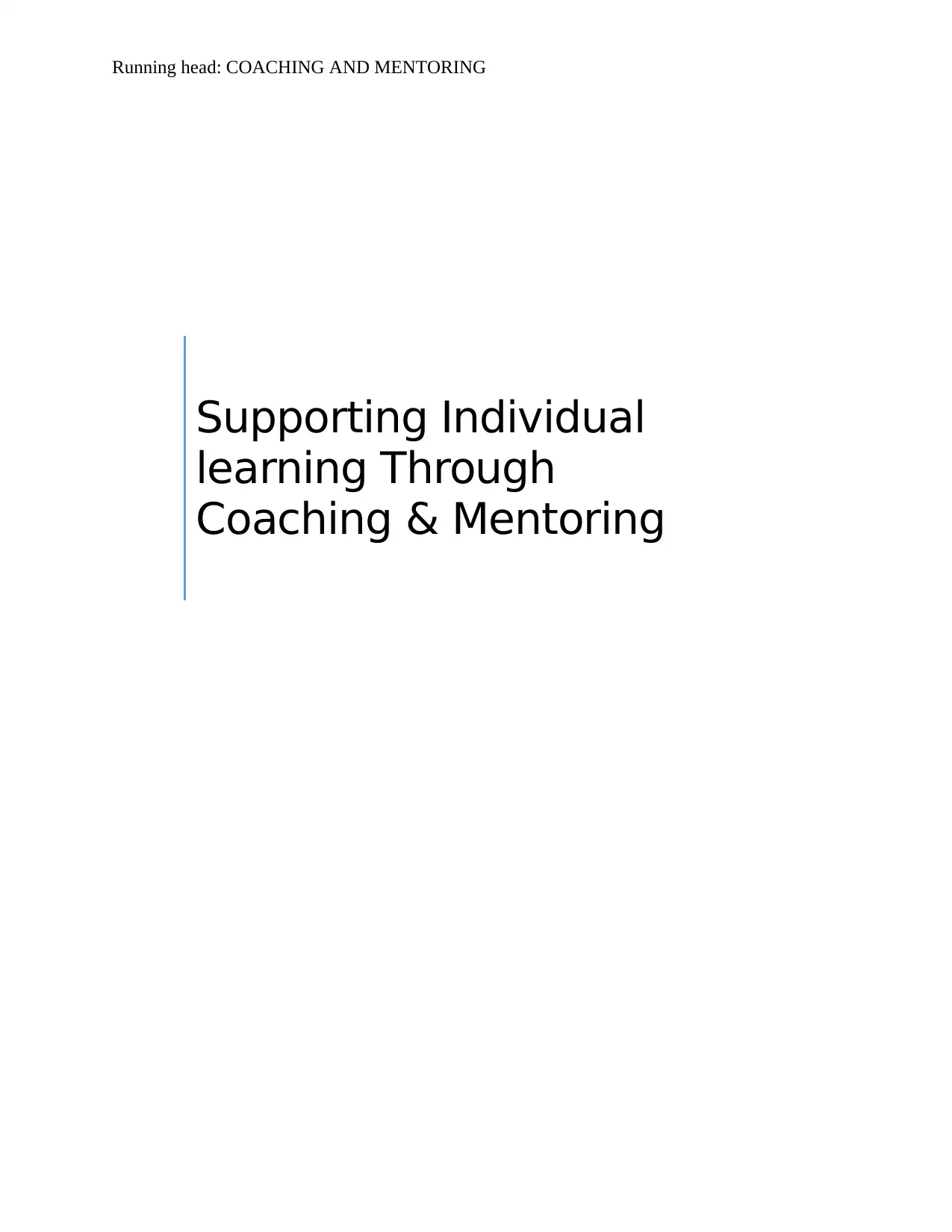
Running head: COACHING AND MENTORING
Supporting Individual
learning Through
Coaching & Mentoring
Supporting Individual
learning Through
Coaching & Mentoring
Paraphrase This Document
Need a fresh take? Get an instant paraphrase of this document with our AI Paraphraser
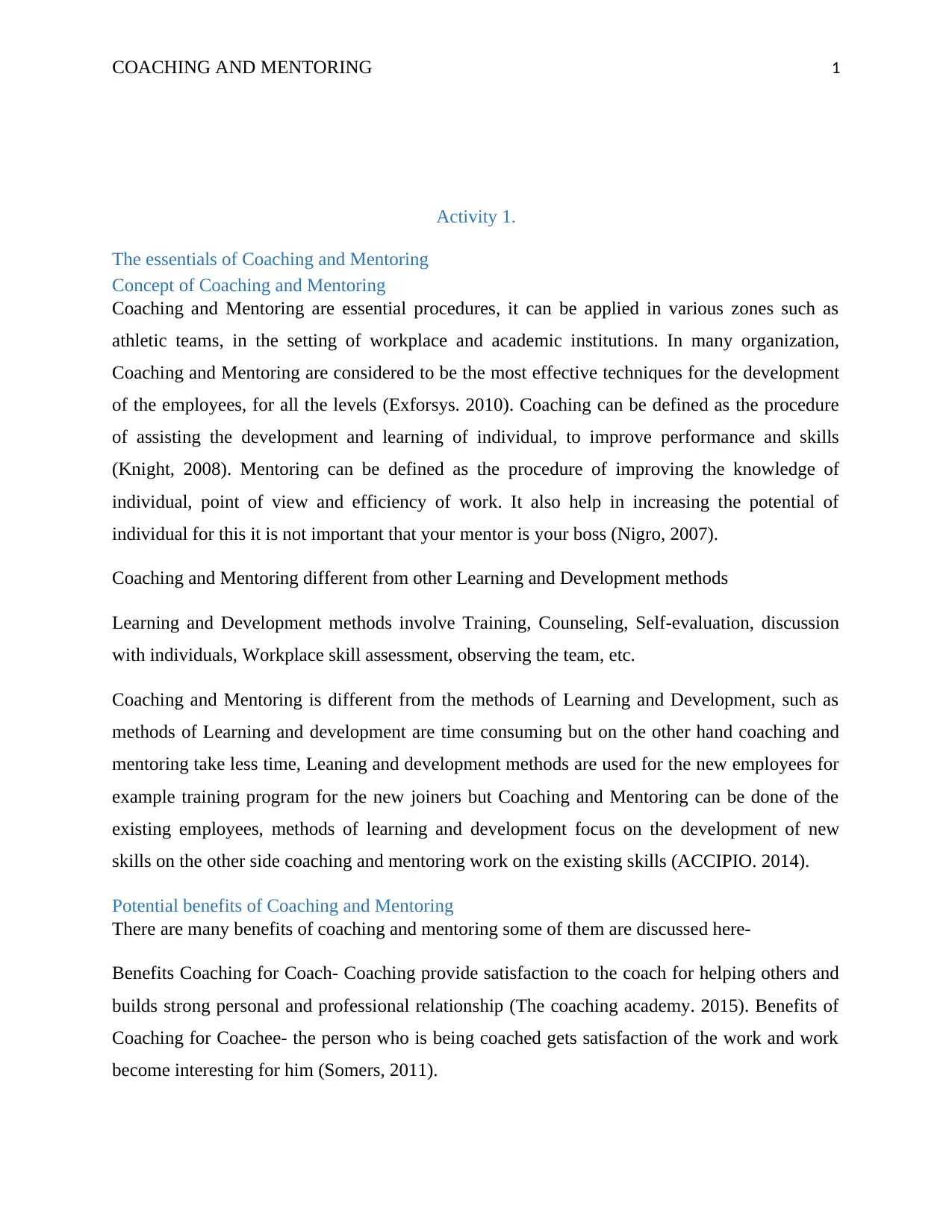
COACHING AND MENTORING 1
Activity 1.
The essentials of Coaching and Mentoring
Concept of Coaching and Mentoring
Coaching and Mentoring are essential procedures, it can be applied in various zones such as
athletic teams, in the setting of workplace and academic institutions. In many organization,
Coaching and Mentoring are considered to be the most effective techniques for the development
of the employees, for all the levels (Exforsys. 2010). Coaching can be defined as the procedure
of assisting the development and learning of individual, to improve performance and skills
(Knight, 2008). Mentoring can be defined as the procedure of improving the knowledge of
individual, point of view and efficiency of work. It also help in increasing the potential of
individual for this it is not important that your mentor is your boss (Nigro, 2007).
Coaching and Mentoring different from other Learning and Development methods
Learning and Development methods involve Training, Counseling, Self-evaluation, discussion
with individuals, Workplace skill assessment, observing the team, etc.
Coaching and Mentoring is different from the methods of Learning and Development, such as
methods of Learning and development are time consuming but on the other hand coaching and
mentoring take less time, Leaning and development methods are used for the new employees for
example training program for the new joiners but Coaching and Mentoring can be done of the
existing employees, methods of learning and development focus on the development of new
skills on the other side coaching and mentoring work on the existing skills (ACCIPIO. 2014).
Potential benefits of Coaching and Mentoring
There are many benefits of coaching and mentoring some of them are discussed here-
Benefits Coaching for Coach- Coaching provide satisfaction to the coach for helping others and
builds strong personal and professional relationship (The coaching academy. 2015). Benefits of
Coaching for Coachee- the person who is being coached gets satisfaction of the work and work
become interesting for him (Somers, 2011).
Activity 1.
The essentials of Coaching and Mentoring
Concept of Coaching and Mentoring
Coaching and Mentoring are essential procedures, it can be applied in various zones such as
athletic teams, in the setting of workplace and academic institutions. In many organization,
Coaching and Mentoring are considered to be the most effective techniques for the development
of the employees, for all the levels (Exforsys. 2010). Coaching can be defined as the procedure
of assisting the development and learning of individual, to improve performance and skills
(Knight, 2008). Mentoring can be defined as the procedure of improving the knowledge of
individual, point of view and efficiency of work. It also help in increasing the potential of
individual for this it is not important that your mentor is your boss (Nigro, 2007).
Coaching and Mentoring different from other Learning and Development methods
Learning and Development methods involve Training, Counseling, Self-evaluation, discussion
with individuals, Workplace skill assessment, observing the team, etc.
Coaching and Mentoring is different from the methods of Learning and Development, such as
methods of Learning and development are time consuming but on the other hand coaching and
mentoring take less time, Leaning and development methods are used for the new employees for
example training program for the new joiners but Coaching and Mentoring can be done of the
existing employees, methods of learning and development focus on the development of new
skills on the other side coaching and mentoring work on the existing skills (ACCIPIO. 2014).
Potential benefits of Coaching and Mentoring
There are many benefits of coaching and mentoring some of them are discussed here-
Benefits Coaching for Coach- Coaching provide satisfaction to the coach for helping others and
builds strong personal and professional relationship (The coaching academy. 2015). Benefits of
Coaching for Coachee- the person who is being coached gets satisfaction of the work and work
become interesting for him (Somers, 2011).
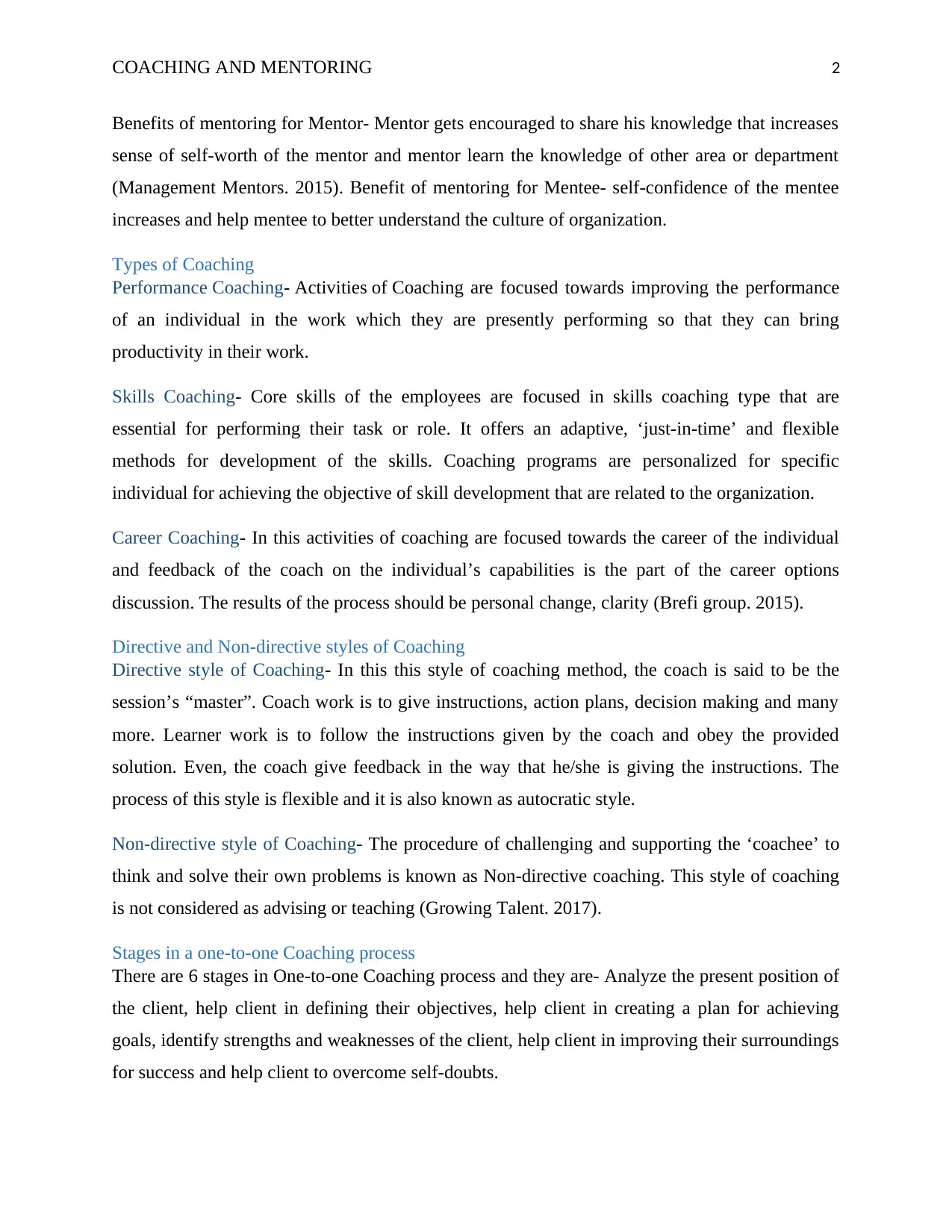
COACHING AND MENTORING 2
Benefits of mentoring for Mentor- Mentor gets encouraged to share his knowledge that increases
sense of self-worth of the mentor and mentor learn the knowledge of other area or department
(Management Mentors. 2015). Benefit of mentoring for Mentee- self-confidence of the mentee
increases and help mentee to better understand the culture of organization.
Types of Coaching
Performance Coaching- Activities of Coaching are focused towards improving the performance
of an individual in the work which they are presently performing so that they can bring
productivity in their work.
Skills Coaching- Core skills of the employees are focused in skills coaching type that are
essential for performing their task or role. It offers an adaptive, ‘just-in-time’ and flexible
methods for development of the skills. Coaching programs are personalized for specific
individual for achieving the objective of skill development that are related to the organization.
Career Coaching- In this activities of coaching are focused towards the career of the individual
and feedback of the coach on the individual’s capabilities is the part of the career options
discussion. The results of the process should be personal change, clarity (Brefi group. 2015).
Directive and Non-directive styles of Coaching
Directive style of Coaching- In this this style of coaching method, the coach is said to be the
session’s “master”. Coach work is to give instructions, action plans, decision making and many
more. Learner work is to follow the instructions given by the coach and obey the provided
solution. Even, the coach give feedback in the way that he/she is giving the instructions. The
process of this style is flexible and it is also known as autocratic style.
Non-directive style of Coaching- The procedure of challenging and supporting the ‘coachee’ to
think and solve their own problems is known as Non-directive coaching. This style of coaching
is not considered as advising or teaching (Growing Talent. 2017).
Stages in a one-to-one Coaching process
There are 6 stages in One-to-one Coaching process and they are- Analyze the present position of
the client, help client in defining their objectives, help client in creating a plan for achieving
goals, identify strengths and weaknesses of the client, help client in improving their surroundings
for success and help client to overcome self-doubts.
Benefits of mentoring for Mentor- Mentor gets encouraged to share his knowledge that increases
sense of self-worth of the mentor and mentor learn the knowledge of other area or department
(Management Mentors. 2015). Benefit of mentoring for Mentee- self-confidence of the mentee
increases and help mentee to better understand the culture of organization.
Types of Coaching
Performance Coaching- Activities of Coaching are focused towards improving the performance
of an individual in the work which they are presently performing so that they can bring
productivity in their work.
Skills Coaching- Core skills of the employees are focused in skills coaching type that are
essential for performing their task or role. It offers an adaptive, ‘just-in-time’ and flexible
methods for development of the skills. Coaching programs are personalized for specific
individual for achieving the objective of skill development that are related to the organization.
Career Coaching- In this activities of coaching are focused towards the career of the individual
and feedback of the coach on the individual’s capabilities is the part of the career options
discussion. The results of the process should be personal change, clarity (Brefi group. 2015).
Directive and Non-directive styles of Coaching
Directive style of Coaching- In this this style of coaching method, the coach is said to be the
session’s “master”. Coach work is to give instructions, action plans, decision making and many
more. Learner work is to follow the instructions given by the coach and obey the provided
solution. Even, the coach give feedback in the way that he/she is giving the instructions. The
process of this style is flexible and it is also known as autocratic style.
Non-directive style of Coaching- The procedure of challenging and supporting the ‘coachee’ to
think and solve their own problems is known as Non-directive coaching. This style of coaching
is not considered as advising or teaching (Growing Talent. 2017).
Stages in a one-to-one Coaching process
There are 6 stages in One-to-one Coaching process and they are- Analyze the present position of
the client, help client in defining their objectives, help client in creating a plan for achieving
goals, identify strengths and weaknesses of the client, help client in improving their surroundings
for success and help client to overcome self-doubts.
⊘ This is a preview!⊘
Do you want full access?
Subscribe today to unlock all pages.

Trusted by 1+ million students worldwide
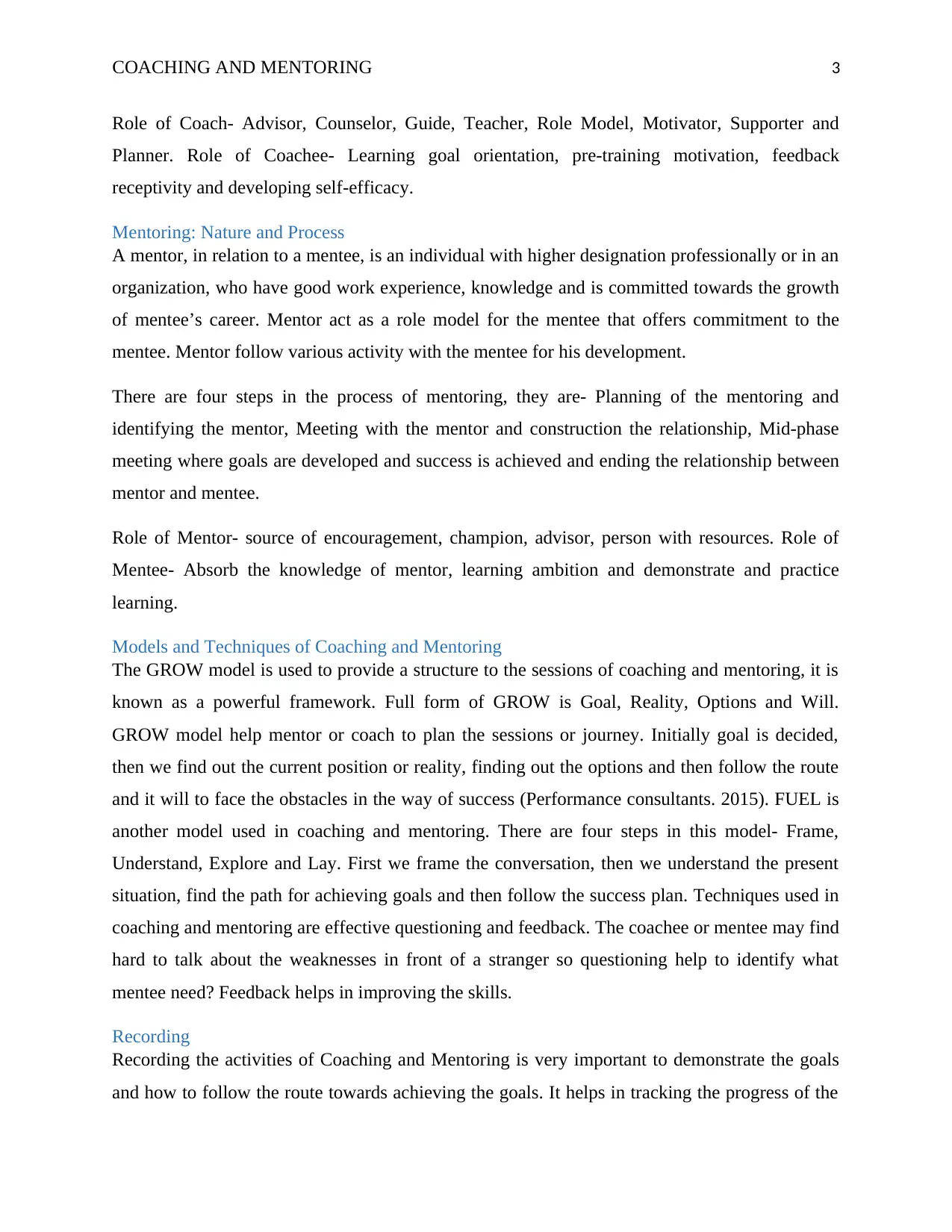
COACHING AND MENTORING 3
Role of Coach- Advisor, Counselor, Guide, Teacher, Role Model, Motivator, Supporter and
Planner. Role of Coachee- Learning goal orientation, pre-training motivation, feedback
receptivity and developing self-efficacy.
Mentoring: Nature and Process
A mentor, in relation to a mentee, is an individual with higher designation professionally or in an
organization, who have good work experience, knowledge and is committed towards the growth
of mentee’s career. Mentor act as a role model for the mentee that offers commitment to the
mentee. Mentor follow various activity with the mentee for his development.
There are four steps in the process of mentoring, they are- Planning of the mentoring and
identifying the mentor, Meeting with the mentor and construction the relationship, Mid-phase
meeting where goals are developed and success is achieved and ending the relationship between
mentor and mentee.
Role of Mentor- source of encouragement, champion, advisor, person with resources. Role of
Mentee- Absorb the knowledge of mentor, learning ambition and demonstrate and practice
learning.
Models and Techniques of Coaching and Mentoring
The GROW model is used to provide a structure to the sessions of coaching and mentoring, it is
known as a powerful framework. Full form of GROW is Goal, Reality, Options and Will.
GROW model help mentor or coach to plan the sessions or journey. Initially goal is decided,
then we find out the current position or reality, finding out the options and then follow the route
and it will to face the obstacles in the way of success (Performance consultants. 2015). FUEL is
another model used in coaching and mentoring. There are four steps in this model- Frame,
Understand, Explore and Lay. First we frame the conversation, then we understand the present
situation, find the path for achieving goals and then follow the success plan. Techniques used in
coaching and mentoring are effective questioning and feedback. The coachee or mentee may find
hard to talk about the weaknesses in front of a stranger so questioning help to identify what
mentee need? Feedback helps in improving the skills.
Recording
Recording the activities of Coaching and Mentoring is very important to demonstrate the goals
and how to follow the route towards achieving the goals. It helps in tracking the progress of the
Role of Coach- Advisor, Counselor, Guide, Teacher, Role Model, Motivator, Supporter and
Planner. Role of Coachee- Learning goal orientation, pre-training motivation, feedback
receptivity and developing self-efficacy.
Mentoring: Nature and Process
A mentor, in relation to a mentee, is an individual with higher designation professionally or in an
organization, who have good work experience, knowledge and is committed towards the growth
of mentee’s career. Mentor act as a role model for the mentee that offers commitment to the
mentee. Mentor follow various activity with the mentee for his development.
There are four steps in the process of mentoring, they are- Planning of the mentoring and
identifying the mentor, Meeting with the mentor and construction the relationship, Mid-phase
meeting where goals are developed and success is achieved and ending the relationship between
mentor and mentee.
Role of Mentor- source of encouragement, champion, advisor, person with resources. Role of
Mentee- Absorb the knowledge of mentor, learning ambition and demonstrate and practice
learning.
Models and Techniques of Coaching and Mentoring
The GROW model is used to provide a structure to the sessions of coaching and mentoring, it is
known as a powerful framework. Full form of GROW is Goal, Reality, Options and Will.
GROW model help mentor or coach to plan the sessions or journey. Initially goal is decided,
then we find out the current position or reality, finding out the options and then follow the route
and it will to face the obstacles in the way of success (Performance consultants. 2015). FUEL is
another model used in coaching and mentoring. There are four steps in this model- Frame,
Understand, Explore and Lay. First we frame the conversation, then we understand the present
situation, find the path for achieving goals and then follow the success plan. Techniques used in
coaching and mentoring are effective questioning and feedback. The coachee or mentee may find
hard to talk about the weaknesses in front of a stranger so questioning help to identify what
mentee need? Feedback helps in improving the skills.
Recording
Recording the activities of Coaching and Mentoring is very important to demonstrate the goals
and how to follow the route towards achieving the goals. It helps in tracking the progress of the
Paraphrase This Document
Need a fresh take? Get an instant paraphrase of this document with our AI Paraphraser
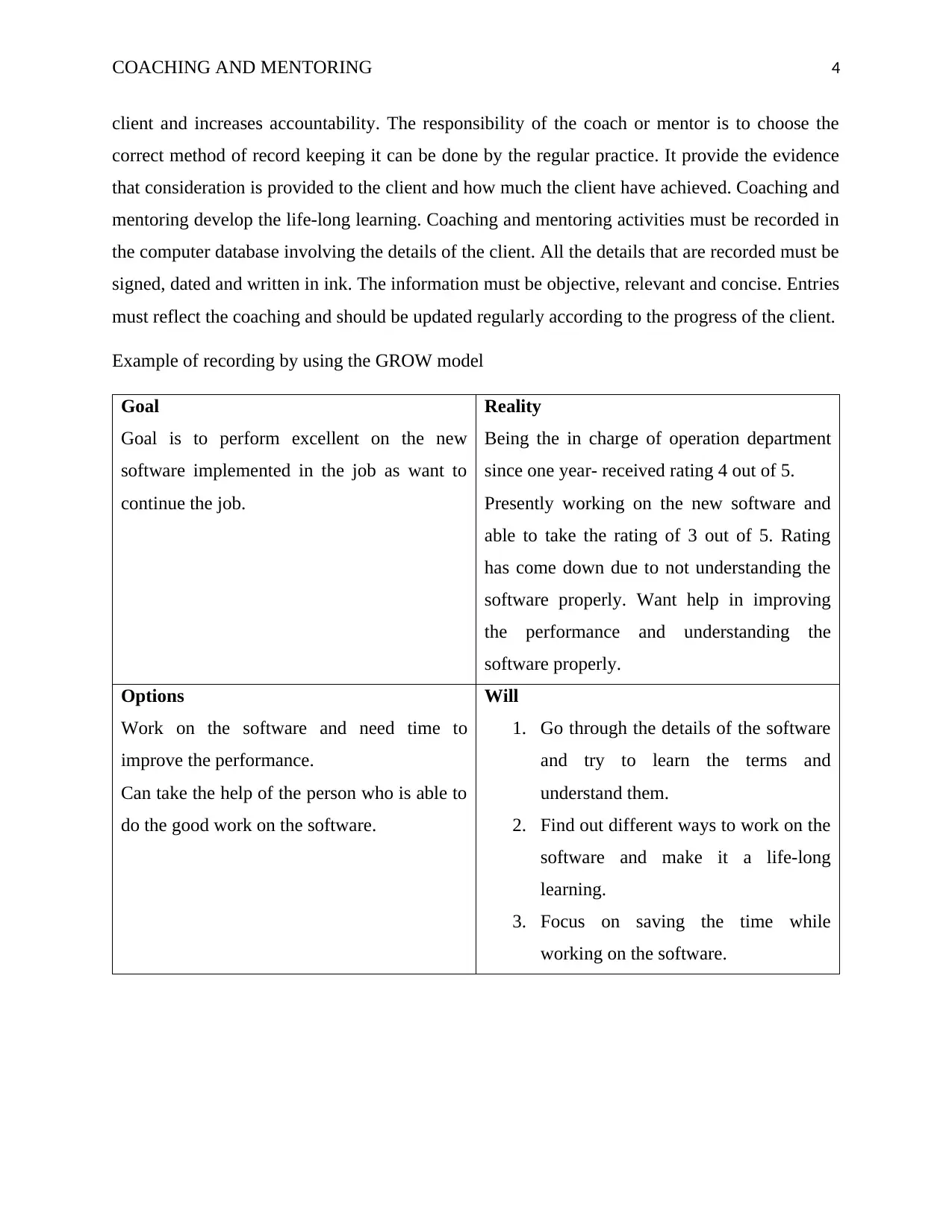
COACHING AND MENTORING 4
client and increases accountability. The responsibility of the coach or mentor is to choose the
correct method of record keeping it can be done by the regular practice. It provide the evidence
that consideration is provided to the client and how much the client have achieved. Coaching and
mentoring develop the life-long learning. Coaching and mentoring activities must be recorded in
the computer database involving the details of the client. All the details that are recorded must be
signed, dated and written in ink. The information must be objective, relevant and concise. Entries
must reflect the coaching and should be updated regularly according to the progress of the client.
Example of recording by using the GROW model
Goal
Goal is to perform excellent on the new
software implemented in the job as want to
continue the job.
Reality
Being the in charge of operation department
since one year- received rating 4 out of 5.
Presently working on the new software and
able to take the rating of 3 out of 5. Rating
has come down due to not understanding the
software properly. Want help in improving
the performance and understanding the
software properly.
Options
Work on the software and need time to
improve the performance.
Can take the help of the person who is able to
do the good work on the software.
Will
1. Go through the details of the software
and try to learn the terms and
understand them.
2. Find out different ways to work on the
software and make it a life-long
learning.
3. Focus on saving the time while
working on the software.
client and increases accountability. The responsibility of the coach or mentor is to choose the
correct method of record keeping it can be done by the regular practice. It provide the evidence
that consideration is provided to the client and how much the client have achieved. Coaching and
mentoring develop the life-long learning. Coaching and mentoring activities must be recorded in
the computer database involving the details of the client. All the details that are recorded must be
signed, dated and written in ink. The information must be objective, relevant and concise. Entries
must reflect the coaching and should be updated regularly according to the progress of the client.
Example of recording by using the GROW model
Goal
Goal is to perform excellent on the new
software implemented in the job as want to
continue the job.
Reality
Being the in charge of operation department
since one year- received rating 4 out of 5.
Presently working on the new software and
able to take the rating of 3 out of 5. Rating
has come down due to not understanding the
software properly. Want help in improving
the performance and understanding the
software properly.
Options
Work on the software and need time to
improve the performance.
Can take the help of the person who is able to
do the good work on the software.
Will
1. Go through the details of the software
and try to learn the terms and
understand them.
2. Find out different ways to work on the
software and make it a life-long
learning.
3. Focus on saving the time while
working on the software.
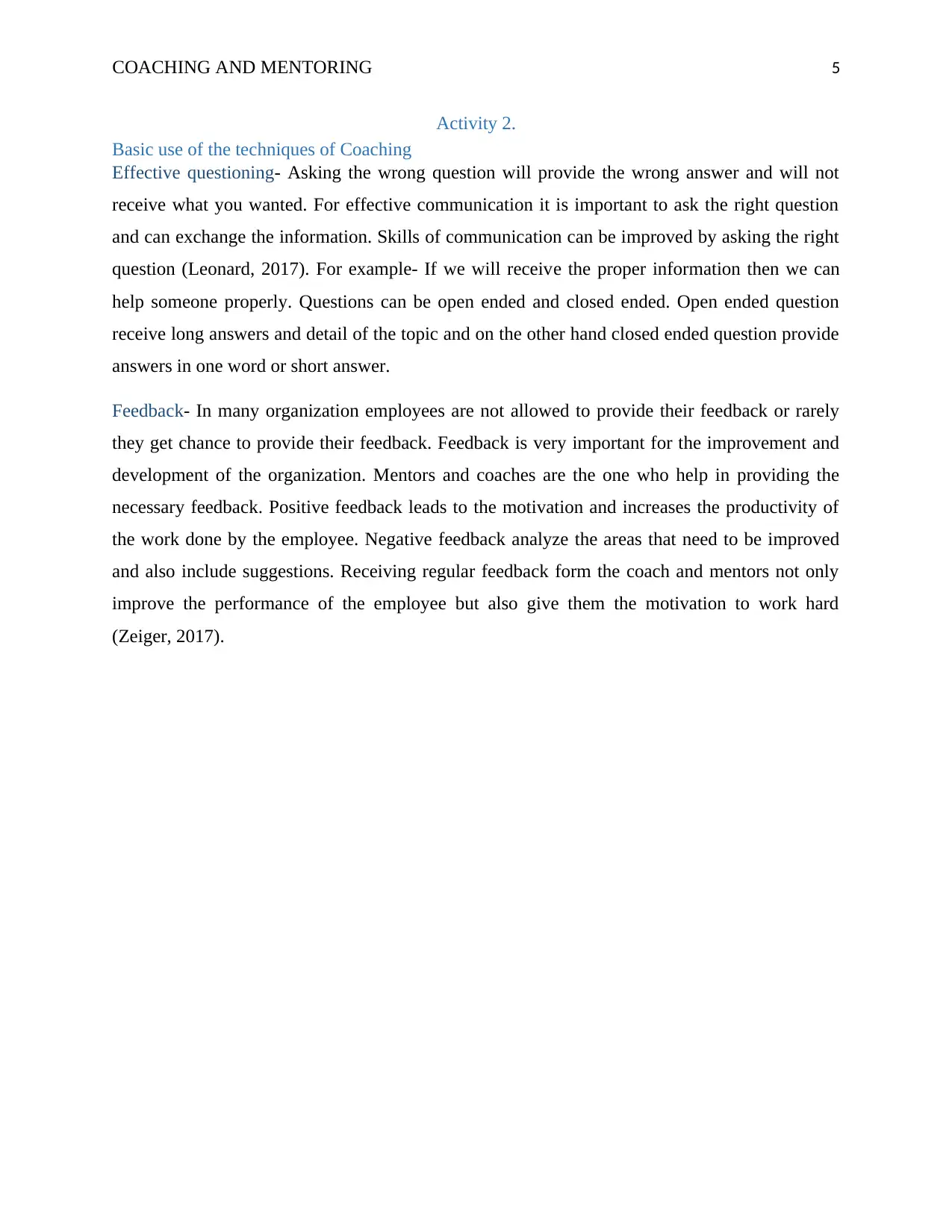
COACHING AND MENTORING 5
Activity 2.
Basic use of the techniques of Coaching
Effective questioning- Asking the wrong question will provide the wrong answer and will not
receive what you wanted. For effective communication it is important to ask the right question
and can exchange the information. Skills of communication can be improved by asking the right
question (Leonard, 2017). For example- If we will receive the proper information then we can
help someone properly. Questions can be open ended and closed ended. Open ended question
receive long answers and detail of the topic and on the other hand closed ended question provide
answers in one word or short answer.
Feedback- In many organization employees are not allowed to provide their feedback or rarely
they get chance to provide their feedback. Feedback is very important for the improvement and
development of the organization. Mentors and coaches are the one who help in providing the
necessary feedback. Positive feedback leads to the motivation and increases the productivity of
the work done by the employee. Negative feedback analyze the areas that need to be improved
and also include suggestions. Receiving regular feedback form the coach and mentors not only
improve the performance of the employee but also give them the motivation to work hard
(Zeiger, 2017).
Activity 2.
Basic use of the techniques of Coaching
Effective questioning- Asking the wrong question will provide the wrong answer and will not
receive what you wanted. For effective communication it is important to ask the right question
and can exchange the information. Skills of communication can be improved by asking the right
question (Leonard, 2017). For example- If we will receive the proper information then we can
help someone properly. Questions can be open ended and closed ended. Open ended question
receive long answers and detail of the topic and on the other hand closed ended question provide
answers in one word or short answer.
Feedback- In many organization employees are not allowed to provide their feedback or rarely
they get chance to provide their feedback. Feedback is very important for the improvement and
development of the organization. Mentors and coaches are the one who help in providing the
necessary feedback. Positive feedback leads to the motivation and increases the productivity of
the work done by the employee. Negative feedback analyze the areas that need to be improved
and also include suggestions. Receiving regular feedback form the coach and mentors not only
improve the performance of the employee but also give them the motivation to work hard
(Zeiger, 2017).
⊘ This is a preview!⊘
Do you want full access?
Subscribe today to unlock all pages.

Trusted by 1+ million students worldwide
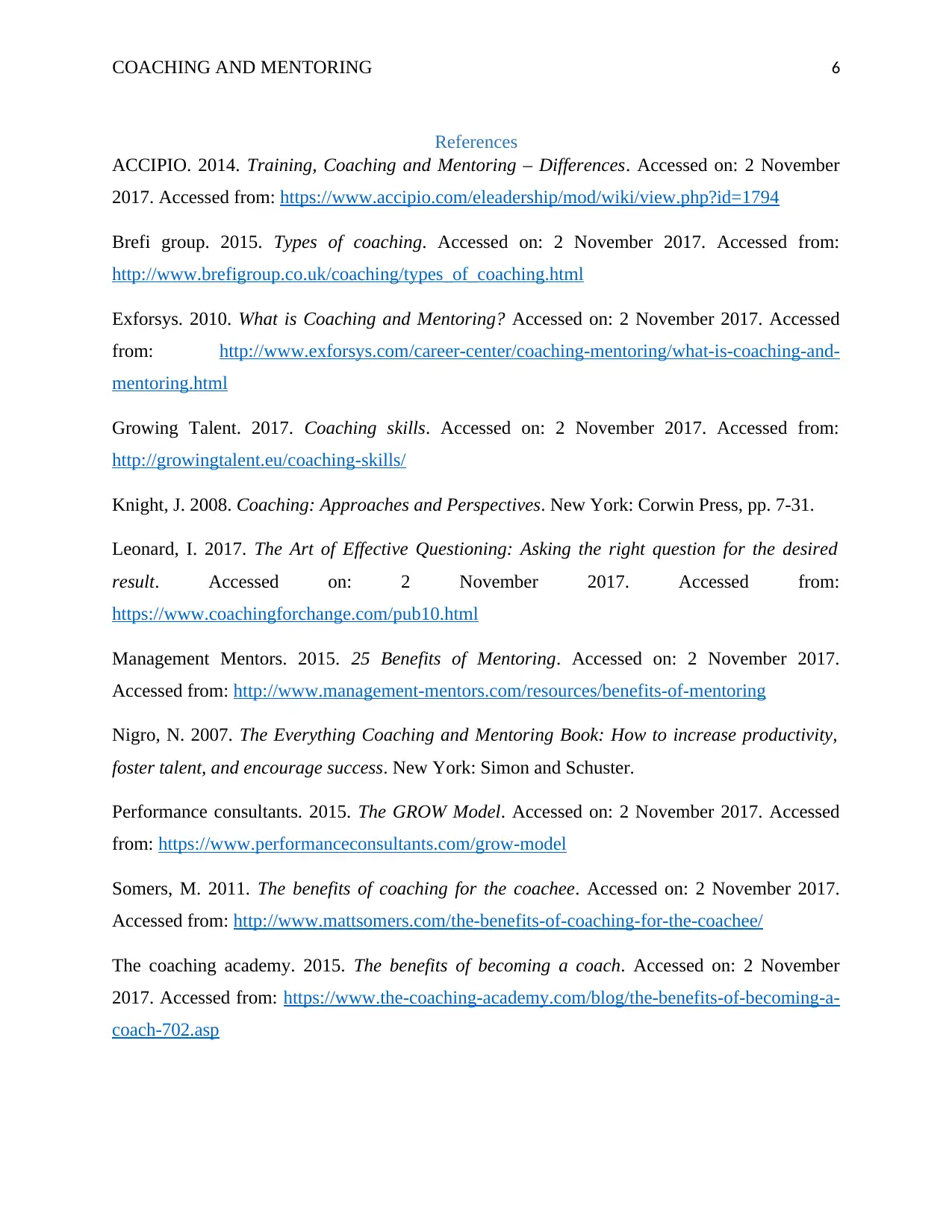
COACHING AND MENTORING 6
References
ACCIPIO. 2014. Training, Coaching and Mentoring – Differences. Accessed on: 2 November
2017. Accessed from: https://www.accipio.com/eleadership/mod/wiki/view.php?id=1794
Brefi group. 2015. Types of coaching. Accessed on: 2 November 2017. Accessed from:
http://www.brefigroup.co.uk/coaching/types_of_coaching.html
Exforsys. 2010. What is Coaching and Mentoring? Accessed on: 2 November 2017. Accessed
from: http://www.exforsys.com/career-center/coaching-mentoring/what-is-coaching-and-
mentoring.html
Growing Talent. 2017. Coaching skills. Accessed on: 2 November 2017. Accessed from:
http://growingtalent.eu/coaching-skills/
Knight, J. 2008. Coaching: Approaches and Perspectives. New York: Corwin Press, pp. 7-31.
Leonard, I. 2017. The Art of Effective Questioning: Asking the right question for the desired
result. Accessed on: 2 November 2017. Accessed from:
https://www.coachingforchange.com/pub10.html
Management Mentors. 2015. 25 Benefits of Mentoring. Accessed on: 2 November 2017.
Accessed from: http://www.management-mentors.com/resources/benefits-of-mentoring
Nigro, N. 2007. The Everything Coaching and Mentoring Book: How to increase productivity,
foster talent, and encourage success. New York: Simon and Schuster.
Performance consultants. 2015. The GROW Model. Accessed on: 2 November 2017. Accessed
from: https://www.performanceconsultants.com/grow-model
Somers, M. 2011. The benefits of coaching for the coachee. Accessed on: 2 November 2017.
Accessed from: http://www.mattsomers.com/the-benefits-of-coaching-for-the-coachee/
The coaching academy. 2015. The benefits of becoming a coach. Accessed on: 2 November
2017. Accessed from: https://www.the-coaching-academy.com/blog/the-benefits-of-becoming-a-
coach-702.asp
References
ACCIPIO. 2014. Training, Coaching and Mentoring – Differences. Accessed on: 2 November
2017. Accessed from: https://www.accipio.com/eleadership/mod/wiki/view.php?id=1794
Brefi group. 2015. Types of coaching. Accessed on: 2 November 2017. Accessed from:
http://www.brefigroup.co.uk/coaching/types_of_coaching.html
Exforsys. 2010. What is Coaching and Mentoring? Accessed on: 2 November 2017. Accessed
from: http://www.exforsys.com/career-center/coaching-mentoring/what-is-coaching-and-
mentoring.html
Growing Talent. 2017. Coaching skills. Accessed on: 2 November 2017. Accessed from:
http://growingtalent.eu/coaching-skills/
Knight, J. 2008. Coaching: Approaches and Perspectives. New York: Corwin Press, pp. 7-31.
Leonard, I. 2017. The Art of Effective Questioning: Asking the right question for the desired
result. Accessed on: 2 November 2017. Accessed from:
https://www.coachingforchange.com/pub10.html
Management Mentors. 2015. 25 Benefits of Mentoring. Accessed on: 2 November 2017.
Accessed from: http://www.management-mentors.com/resources/benefits-of-mentoring
Nigro, N. 2007. The Everything Coaching and Mentoring Book: How to increase productivity,
foster talent, and encourage success. New York: Simon and Schuster.
Performance consultants. 2015. The GROW Model. Accessed on: 2 November 2017. Accessed
from: https://www.performanceconsultants.com/grow-model
Somers, M. 2011. The benefits of coaching for the coachee. Accessed on: 2 November 2017.
Accessed from: http://www.mattsomers.com/the-benefits-of-coaching-for-the-coachee/
The coaching academy. 2015. The benefits of becoming a coach. Accessed on: 2 November
2017. Accessed from: https://www.the-coaching-academy.com/blog/the-benefits-of-becoming-a-
coach-702.asp
Paraphrase This Document
Need a fresh take? Get an instant paraphrase of this document with our AI Paraphraser

COACHING AND MENTORING 7
Zeiger, S. 2017. Strategies and Techniques for Mentoring and Coaching. Accessed on: 2
November 2017. Accessed from: http://smallbusiness.chron.com/strategies-techniques-
mentoring-coaching-23317.html
Zeiger, S. 2017. Strategies and Techniques for Mentoring and Coaching. Accessed on: 2
November 2017. Accessed from: http://smallbusiness.chron.com/strategies-techniques-
mentoring-coaching-23317.html
1 out of 8
Related Documents
Your All-in-One AI-Powered Toolkit for Academic Success.
+13062052269
info@desklib.com
Available 24*7 on WhatsApp / Email
![[object Object]](/_next/static/media/star-bottom.7253800d.svg)
Unlock your academic potential
Copyright © 2020–2025 A2Z Services. All Rights Reserved. Developed and managed by ZUCOL.





